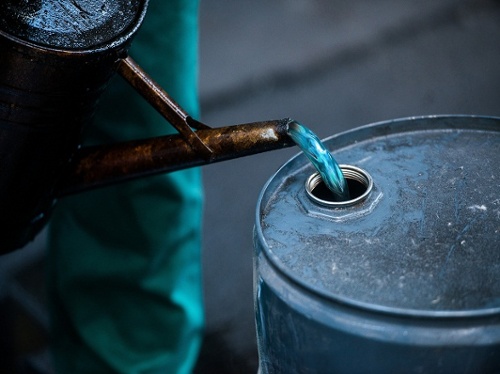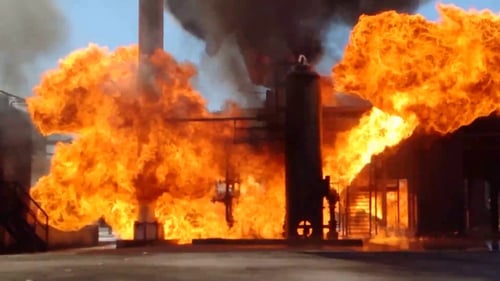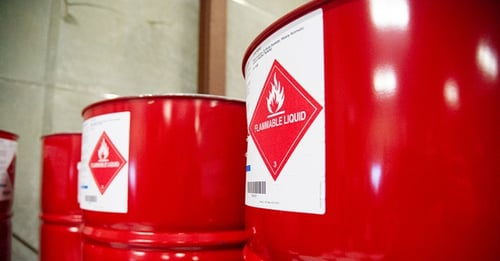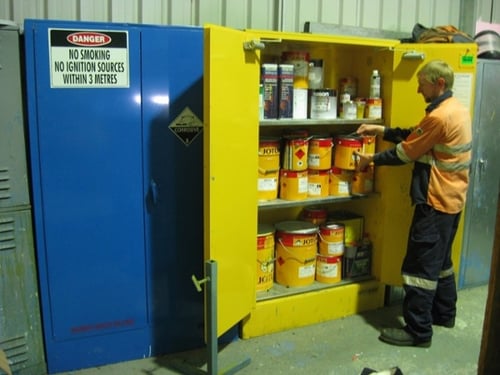When you work with Class 3 Flammable Liquids, it’s important to understand the chemical and physical properties of the specific product that you’re using. Flammable liquids can ignite and explode, causing damage to people, property and the environment. Two important considerations when studying the Safety Data Sheet of your chemicals is the flash point and the auto-ignition temperature of your flammable liquids. In this blog, we look more closely at the difference between the flash point and auto-ignition temperature for Class 3 liquids. We’ll also explain some risk control measures that you can implement to ensure that your liquid chemicals are handled and stored in a safe way.
But first, we’ll give the definition of a flammable liquid as provided by the Australian Dangerous Goods (ADG) code.
What Is A Flammable Liquid?
The ADG code offers this definition of flammable liquids:
“liquids, or mixtures of liquids, or liquids containing solids in solution or suspension (for example, paints, varnishes, lacquers, etc., but not including substances otherwise classified on account of their dangerous characteristics) which give off a flammable vapour at temperatures of not more than 60 °C, closed-cup test, or not more than 65.6 °C, open-cup test, normally referred to as the flash point.”
As the name suggests, a Class 3 Flammable Liquid is a substance which can ignite and cause a fire or explosion. For businesses carrying this class of dangerous goods, the prevention of incidents such as fires, flashbacks and explosions is extremely important when determining your handling procedures and storage requirements.
The ADG code’s definition of flammable liquids explains that a chemical is considered a flammable liquid if it can produce sufficient flammable vapours for ignition — at temperatures less than 60 °C.
For many businesses, flammable liquids will be handled, transferred or stored in ambient conditions which are within this temperature range. Therefore, understanding the flammability of your substance is crucial if you want to protect your business from incidents of fire — and meet your compliance obligations under WHS Regulations.
Flash Point
The flash point is used to determine if a chemical is a flammable liquid, a non-flammable liquid or a combustible liquid. Flash point is defined as the lowest temperature at which a chemical can ignite in the presence of an ignition source.

Flammable liquids are substances which can emit sufficient flammable vapours to ignite in the presence of an ignition source at temperatures less than 60 °C.
When temperatures increase, flammable liquids emit flammable vapours which can ignite if they meet an ignition source. Flammable vapours can quickly travel through workplaces, travelling down stairwells, into other rooms and into outdoor areas. Therefore, these flammable vapours have a very high risk of coming into contact with a workplace ignition source.
Examples Of Flammable Liquid Flash Points
The flash point for flammable liquids can be within normal working temperatures — and is considered a low flash point when compared with other types of chemicals. The lower the flash point of a substance, the greater the risk that it will ignite and cause a fire.
Some examples of flammable liquid flash points include:
- Acetone -20 °C
- Benzene -12 °C
- Ethanol 16.6 °C
- Kerosene 38 °C
- Methanol 11-12 °C
Ignition Sources
The flash point, or lowest temperature at which a flammable liquid can ignite, can be the deciding factor if a fire occurs in a flammable liquids storage or handling area. But what is an ignition source and where are they present in the workplace environment?
Ignition sources are present in almost every type of workplace — and they’re not always easy to identify. Sources of ignition may be thermal, electrical, mechanical or chemical and include static electricity, mechanical sparks, hot surfaces, welding arcs and naked flames.

Identifying and isolating ignition sources in flammable liquids handling and storage areas is essential in reducing the risk of fire and explosion.
Regardless of the quantity of type of flammable liquid that you’re carrying, you must always identify and isolate ignition sources from all flammable liquids handling, transferring and storage areas.
While flammable liquids are defined by their low flash point, this is not to be confused with the auto-ignition range of the chemical.
IMPORTANT: When storing flammable liquids, ensure that your cabinet or store is installed at least 3 metres away from any type of ignition source, including power points, electrical equipment and hot work.
Auto-Ignition Temperature
While the flash point is the ambient temperature at which the chemical can spark or ignite (if it meets an ignition source), the auto-ignition temperature is the lowest ambient temperature at which the chemical will spontaneously combust (without an ignition source).
Auto-ignition temperatures are generally higher than flash points, which may be within the normal working temperature range of your workplace. However, just because auto-ignition temperatures are usually within a higher temperature range, it doesn’t mean that there is not a risk to your organisation if that chemical isn’t stored or handled in a safe manner.
Knowing the chemical properties of your flammable liquids, including the flash point and the auto-ignition range of the substance, is a vital part of understanding how you can control risks in your own workplace.
Examples Of Auto-Ignition Points
There are many classes of dangerous goods that can spontaneously combust. Chemicals including magnesium, silane, phosphorus, lead, iron and hydrogen can all ignite when they reach a certain ambient temperature.

Spontaneous combustion can occur when flammable liquids reach a high temperature.
Some examples of auto-ignition temperatures for Class 3 Flammable Liquids include:
- Acetic acid 175 °C
- Benzene 298 °C
- Diethylamine 312 °C
- Diethyl Ether 160 °C
- Ethyl acetate 410 °C
- Ethanol 363 °C
- Petrol 247-280 °C
- Kerosene 210 °C
While these temperatures are well outside the normal working temperature range of workplaces, auto-ignition can occur in workplaces when there is a highly elevated ambient temperature. This could include spontaneous combustion during a workplace fire, chemical transportation, manufacturing processes or other circumstances which may trigger a thermal reaction.
Testing Methods For Flash Point and Auto-Ignition Temperatures
Class 3 liquids are tested for their flammability using the open and closed-cup test, through the introduction of an ignition source at a particular temperature. However, the auto-ignition range of a chemical is tested by placing it in a small vessel — which is then transferred to a temperature-controlled oven. Through controlling the temperature of the oven, you can determine the heat at which the chemical spontaneously ignites. This provides the auto-ignition temperature of the substance.
Determining The Flash Point and Auto-Ignition Temperature
To determine the flash point and auto-ignition temperature of your flammable liquid, you should always refer to the Safety Data Sheet (SDS) of your individual chemical product. You will find this information in the physical and chemical properties section of your SDS, along with other important information including the chemical’s physical state, colour, odour, melting point, boiling point and flammability.

Refer to the SDS of your individual chemical products to determine the flash point and auto-ignition temperature of your flammable liquids.
Remember that every type of flammable liquid will have a particular flash point and auto-ignition temperature. Staff should always have access to the SDS and be trained in hazard prevention through flammable liquids safety training.
Controlling Risks
When choosing your flammable liquid products, always ensure that they are fit for purpose and are a necessary chemical for your organisation. As per the Hierarchy of Controls, you should always first consider if it is possible for your organisation to eliminate the hazard (flammable liquids) completely. If this is not possible, consider if you can choose a less flammable chemical to use in place of your current product.
However, for many businesses, it’s simply not practical or feasible to eliminate or substitute flammable liquids. Therefore, it’s important that a system of control measures are put in place to keep your staff, organisation and surrounding community safe from chemical hazards.
To reduce the risk of ignition, explosion or auto-ignition in your flammable liquids work areas, we recommend the following risk control measures and workplace procedures:
- Train staff in flammable liquids safety including training on ignition sources, flash point and auto-ignition ranges
- Choose storage equipment that’s been manufactured to meet the requirements of AS 1940
- Store flammable liquids in compliant containers
- Keep all flammable liquid containers clean and wipe down after use
- Maintain chemical bunds so no flammable liquids residue is left after a leak or spill
- Ensure that no flammable liquids are handled or stored near incompatible substances
- Isolate all ignition sources from flammable liquids handling and storage areas
- Make sure any decanting, pumping or chemical transferal equipment is fit-for-purpose and made from non-combustible materials
- Dispose of any flammable liquid waste in a safe, compliant manner
- Vehicles and equipment used to transfer flammable liquids should be regularly maintained to ensure they don’t jolt, stop or malfunction when in use
- Practice safe loading and stacking practices for all flammable liquid indoor and outdoor stores
- Keep all dangerous goods and hazard signage in good condition and clearly visible
- Ensure that your staff are familiar with emergency procedures
- Attach your SDS to your flammable store
- Prepare an up-to-date manifest of hazardous chemicals

Handling and storage practices for flammable liquids should focus on isolating ignition sources, containing hazardous vapours, preventing spills and reducing the risk of human harm.
Understanding Flash Point and Auto-Ignition Temperatures
One of the first steps in flammable liquids safety is making sure that all staff are aware of the hazards associated with the chemical product – including the temperature at which the liquid can ignite and auto-ignite. Practising safe storage and handling procedures for flammable liquids, as per AS 1940, will help your organisation reduce the likelihood of a fire, flashback or explosion. One of the simplest ways to immediately reduce your chemical compliance risk is by installing a compliant flammable liquids cabinet or flammable liquids storage container. These storage solutions come equipped with a range of control measures including heat and flame protection, spill containment, and dangerous goods and hazard signage.
If you’d like to find out more about maintaining a compliant workplace, why not download our helpful eBook? Essential Considerations When Storing Flammable Liquids Indoors offers practice advice on how to control the risk of fire and explosion in your organisation. Grab your copy for free today by clicking on the image below.
Joining the team as a Dangerous Goods Storage Consultant, Melissa Hampton became Storemasta's Marketing Manager in late 2021. With extensive knowledge and experience in chemical compliance, Melissa is responsible for leading the Marketing team and helping shape their marketing strategy. In her spare time, you can find Melissa hiking, swimming and enjoying the great outdoors in beautiful north-west Tasmania.
